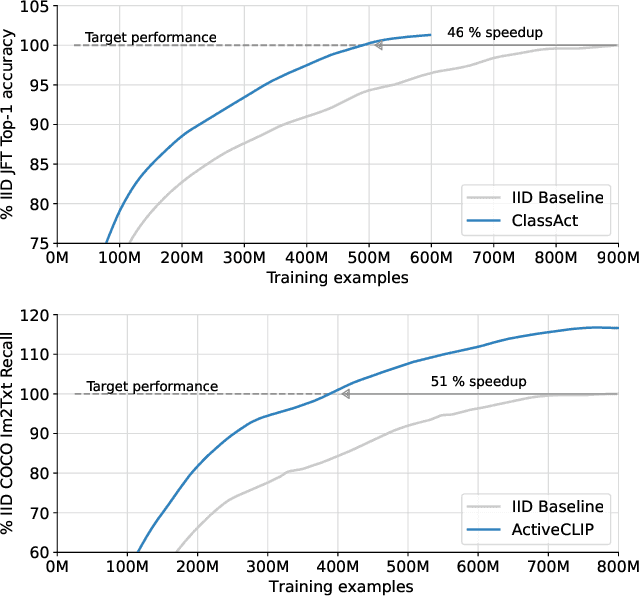Olivier J. Henaff
Data curation via joint example selection further accelerates multimodal learning
Jun 25, 2024Abstract:Data curation is an essential component of large-scale pretraining. In this work, we demonstrate that jointly selecting batches of data is more effective for learning than selecting examples independently. Multimodal contrastive objectives expose the dependencies between data and thus naturally yield criteria for measuring the joint learnability of a batch. We derive a simple and tractable algorithm for selecting such batches, which significantly accelerate training beyond individually-prioritized data points. As performance improves by selecting from larger super-batches, we also leverage recent advances in model approximation to reduce the associated computational overhead. As a result, our approach--multimodal contrastive learning with joint example selection (JEST)--surpasses state-of-the-art models with up to 13$\times$ fewer iterations and 10$\times$ less computation. Essential to the performance of JEST is the ability to steer the data selection process towards the distribution of smaller, well-curated datasets via pretrained reference models, exposing the level of data curation as a new dimension for neural scaling laws.
Bad Students Make Great Teachers: Active Learning Accelerates Large-Scale Visual Understanding
Dec 12, 2023



Abstract:We propose a method for accelerating large-scale pre-training with online data selection policies. For the first time, we demonstrate that model-based data selection can reduce the total computation needed to reach the performance of models trained with uniform sampling. The key insight which enables this "compute-positive" regime is that small models provide good proxies for the loss of much larger models, such that computation spent on scoring data can be drastically scaled down but still significantly accelerate training of the learner.. These data selection policies also strongly generalize across datasets and tasks, opening an avenue for further amortizing the overhead of data scoring by re-using off-the-shelf models and training sequences. Our methods, ClassAct and ActiveCLIP, require 46% and 51% fewer training updates and up to 25% less total computation when training visual classifiers on JFT and multimodal models on ALIGN, respectively. Finally, our paradigm seamlessly applies to the curation of large-scale image-text datasets, yielding a new state-of-the-art in several multimodal transfer tasks and pre-training regimes.
Divide and Contrast: Self-supervised Learning from Uncurated Data
May 17, 2021



Abstract:Self-supervised learning holds promise in leveraging large amounts of unlabeled data, however much of its progress has thus far been limited to highly curated pre-training data such as ImageNet. We explore the effects of contrastive learning from larger, less-curated image datasets such as YFCC, and find there is indeed a large difference in the resulting representation quality. We hypothesize that this curation gap is due to a shift in the distribution of image classes -- which is more diverse and heavy-tailed -- resulting in less relevant negative samples to learn from. We test this hypothesis with a new approach, Divide and Contrast (DnC), which alternates between contrastive learning and clustering-based hard negative mining. When pretrained on less curated datasets, DnC greatly improves the performance of self-supervised learning on downstream tasks, while remaining competitive with the current state-of-the-art on curated datasets.
 Add to Chrome
Add to Chrome Add to Firefox
Add to Firefox Add to Edge
Add to Edge